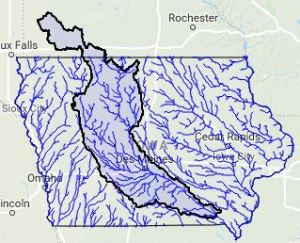Over the next few weeks I am going to post 2017 nitrate data summaries for many Iowa watersheds. These summaries are an aggregation of IIHR and USGS water quality sensor data, Iowa DNR ambient monitoring data, and USGS discharge data. Most of this data is in the metric system, sorry if that isn’t your thing. A key to some of the terms and abbreviations:
Load: total mass of a pollutant transported by a stream over a defined period of time. This is shown in kilograms (kg) in the data below.
Discharge (Q): total amount of stream water traveling past a defined point. This is shown cubic meters per day (m3/day) and millimeters (mm) below. I calculate discharge in mm by dividing the total water volume by the watershed area. This is a convenient way to look at discharge because you can compare it with precipitation in the same units. We also call this method of looking at discharge water yield.
Precipitation (P): average of all the Iowa State Mesonet weather stations in the watershed. I report this in mm.
Q/P: discharge to precipitation ratio. This oftentimes is an important driver for water quality.
Concentration: mass of a pollutant per unit volume of water. I report this as milligrams per liter (mg/L) which is the same as parts per million. My monthly average concentrations are derived from daily averages. For the sensor data, there are 288 measurements per day.

Flow weighted average (FWA) concentration. This is the total load divided by the total discharge. So this is not a daily or monthly average per se, but imagine if we were able to collect in a container all the river water over a defined time period (month or year) and then measure the nitrate concentration in that huge sample. That is FWA. For nitrate, this is oftentimes higher than the regular average over the course of a year.
N yield: this is the load of nitrate per unit area. I deviate from the metric system here and report this value in pounds per acre in the graphs.
Finally, I am reporting this data for the 2017 Water Year, which ran from Oct 1, 2016 to Sep 30, 2017. This is a common way that scientists look at stream data.
The first watershed I’m reporting on here is the Des Moines River at Keosauqua. It is Iowa’s largest interior watershed at 8.98 million acres and extends well into Minnesota. The watershed occupies approximately 1/5th of Iowa’s area. Areas upstream of the city of Des Moines are part of the heavily-tiled Des Moines Lobe Landform, which was glaciated only 12,000 years ago. Prior to European settlement, this area was dominated by wet prairie and wetland ecosystems. Below its confluence with the Raccoon River, the Des Moines River and its tributaries flow through the Southern Iowa Drift Plain, a hillier area that was last glaciated 500,000 years ago.
Approximately 62% of the land area is in corn and soybean production. Major tributaries include the Raccoon R., Boone R., East and West Forks of the Des Moines R., Lizard Cr., Beaver Cr., North R., Middle R., South R., and White Breast Cr. The Des Moines River supplies municipal drinking water to the Des Moines area, Ottumwa, and Boone, and has two major USACE impoundments (Saylorville and Red Rock).
The Des Moines River is one of the 42 largest tributaries to the Mississippi River and is the 35th longest river in the United States (525 miles).
Water quality data are shown below. You can see the total nitrate-nitrogen load for the water year was about 73 million kilograms. The annual average load since 2001 has been about 48 million kilograms.
